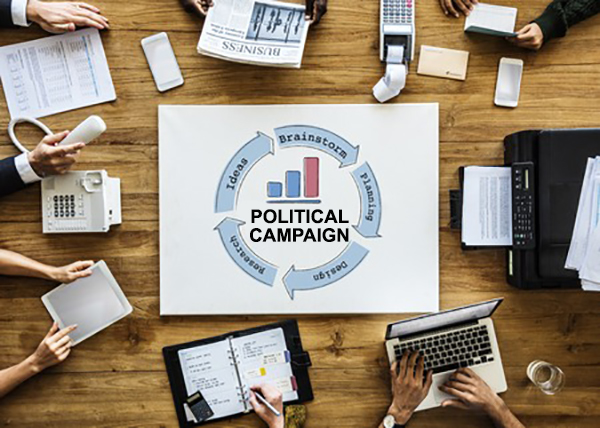So, now that you decided to run for office, what’s next?
The following is a condensed checklist of what you should have already completed by now:
- Analyzed past voter turnout
- Analyzed voter demographics
- Determined your necessary winning number
- Researched expenditures by previous candidates
- Contacted and met with Precinct Chairs
- Contacted Previous Contributors for Fundraising
- Organized your budget expenses: office, voter outreach, advertising, special events, mailings, etc.
- Completed your team organization and structure
- Social Media branding should be in full force
- Reaching out to Absentee Voters should be in the works
- Planning strong Get Out the Vote events should be in the works

ADVERTISING COMPANY vs. CAMPAIGN STRATEGIST
I get many calls from candidates who make the mistake of hiring an advertising company to handle their campaign. While an advertising company can design a nice logo, build you a nice website, and print signs for you, they seldom can advise you on campaign techniques and strategies. This will be crucial, especially if you have a liberal opponent.
I always recommend hiring an experienced campaign strategist. It can save you a lot of headaches.
Have a liberal opponent? Here’s my advice on debating a liberal opponent: You can’t confront an emotionally based moral argument with intellectual analysis, with statistics, facts, or figures. Most voters can’t process statistics as quickly as they can process emotion. This is where a prepared campaign strategist will come in handy. So, prepare wisely.
This year, I see a lot of new candidates across the state running to unseat incumbents. Some new candidates mean well. However, I see some not heeding one of my key advice for effectively communicating a message: “You must know your Audience to prepare your Message, and you must prepare your Message so your Audience will understand it.”
It’s crucial to consider the Audience (voters). More specifically – their perception of the Incumbent. If new candidates come out and their first statement is, “I’m running for office because Incumbent John Doe is bad,” this could backfire.
Why? Because voters in the Audience may genuinely not be informed on Incumbent John Doe’s poor voting record or why he’s bad. Some in the Audience may think Incumbent John Doe is good.
With an initial negative statement against their likable incumbent, voter minds will unconsciously form a skeptical shield towards anything said afterward by the new candidate. Thus, they will block the processing of any evidence that may follow the statement – even if the evidence is factual. The evidence will ‘fall on deaf ears.’
Candidates need to learn to do what I call, ‘walk the brain to the a-ha moment.’ In other words, help the Audience reach a conclusion without initially directly telling them the conclusion.
In this case, provide detailed and researched evidence of why Incumbent John Doe is bad so that the Audience will reach that conclusion on their own. A minimum of 2-3 evidenced backed-up points is necessary for the human brain to start processing the message.
The audience will then be more prone to reach the ‘a-ha moment,’ the moment of realization of why Incumbent John Doe is bad on their own – before the new candidate makes the statement.
Then, when the new candidate later makes the statement Incumbent John Doe is bad, the brain will perceive it as a seal to the conclusion reached with the preceding evidence provided.
And yes, this could also work the other way around. The incumbent could use this against the new candidate.
The way the human brain connects the dots to reach a conclusion and a perception must be understood by new candidates to effectively convey their message and convince their Audience.

DETERMINE YOUR WINNING NUMBER
What’s your Winning Number? The number of votes you need to win an election.
To determine this number, I suggest analyzing the last 3 elections for the position you’re running for (past voter turnout numbers and demographics).
First, gather past voter turnout numbers. Are there any trends or major differences in voter turnout totals? You will see major differences among primary, presidential, and non-presidential elections.
To obtain your necessary Winning Number, there are several determining factors, but I usually recommend taking the average or highest (whichever is greater) amount of voter turnout for the last 3 elections; then, your Winning Number will be 51% of that amount. I recommend my candidates work to obtain a minimum of 56% of that amount.
Depending on the type of campaign you’re running, you should break these analytical results down by county, district, or precinct. The purpose of this is to spend the most time in the areas with the most possible voters and most likely supporters. This will also help you get the most for your time and campaign dollars, especially if you’re block-walking or mailing out postcards.
I once had a candidate tell me that, without any research, he just picked a random street and went door to door. He ended up spending a large amount of valuable time talking to people who either weren’t registered to vote or had never even voted.
MARKETING STRATEGY
Need a marketing strategy for your campaign? Branding and voter perception are key. Remember the saying, ‘You only get one chance to make a good first impression’? Well, the same applies to campaign marketing strategies. You will only have a few seconds to impress or turn away voters with your campaign speech, website, literature, push cards, etc. Here are a few tips:
- Website – You need a website. Unfortunately, the free ones don’t usually get the job done. Remember, branding is key so you’ll need to include your full name as it will appear on the ballot on your domain name. Strong, to-the-point, and factual content is crucial.
- Social Media – Look around. How many people walk around with a newspaper in their hand? a radio? a television? Not many. Look around again. How many people have a smartphone with social media access in their hands? However, social media has changed enormously and requires a financial investment to get any worthy visibility. You will need a professional or someone who understands how to get your message out properly. I get too many candidates who tell me their 7-year-old daughter is handling their social media.
- Images – I’ve had candidates send me pictures from their cell phones to use for their campaign literature. One candidate sent me a picture from her living room where you could see a broken lamp in the background. No. Invest a little with a good photographer.
- Hot Button Issues – Have at least 3 hot-button issues to present to voters. What’s currently bothering voters? Tell voters why it’s to their benefit to vote for you. Running against an incumbent with a bad voting record? You will need to educate voters. You will be surprised how many voters don’t know what goes on behind closed doors at a local city council meeting, much less at the state or national level.
FUNDRAISING
Building a fundraising network is of utmost importance. This network will be made up of supporters committed to helping you raise funds for your campaign.
What can supporters do? Hold events, ask friends, colleagues, and other incumbents without opponents to donate to your campaign. They can also introduce you to people with the interest and capacity to donate.
How can they do this?
• Ask them to introduce you to 2-3 potential donors
• Ask them to send a fundraising email to their friend and political networks
• Ask them to sell tickets to your fundraising events
• Ask them to host a ‘Meet the Candidate’ event
When I talk to some of my small-town candidate clients about creating a fundraising network, they usually think it implies huge PACs and mega-donors. Not so. Small grassroots fundraising networks can be just as effective.
You as the candidate are the key figure in fundraising. Your name, your reputation, your likability, your acquaintances, etc. will play a major role. So, you should first ask family, friends, neighbors, colleagues, and fellow incumbents without opponents to donate to your campaign.
Next, ask others to help you seek donors for your campaign. Especially politically connected people. Very rarely, especially if you’re a new candidate, will you have someone come up to you and say, “Hi, I’m going to help you find donors for your campaign.” So, you’ll have to personally ask. But you must always ask in person or over the phone. Don’t send an email.
Be specific. Supporters and donor-seekers should know exactly what is being asked of them. Also, your fundraising team should know what his or her specific duties are and what can and cannot be said to potential donors.
Last year I worked with a candidate where 60% of the voters in his district had a voting tendency towards the opposing political party. He was able to put together a team of about 200 volunteers to operate a phone bank. Impressive. Except for one thing: He never gave them the script or instructions and guidelines I sent him. He later told me he wanted the calls to sound more spontaneous. That’s fine, but many volunteers later confessed they didn’t know what to say to the people they were calling.
Finally, create a basic fundraising plan. For example, if you need to raise $50,000, you can accomplish this with 100 contributors of $500. Make an initial outline with the amount your campaign will need and people who can donate. For example:
100 contributions x $500 = $50,000
250 contributions x $250 = $50,000
500 contributions x $100 = $50,000
1,000 contributions x $50 = $50,000
2,000 contributions x $25 = $50,000
Need less for a local campaign?
500 contributions x $50 = $25,000
500 contrubtions x $20 = $10,000
200 contributions X $50 – $10,000
200 contributions x $25 = $5,000
100 contributions x $50 = $5,000
Don’t forget, that it is your responsibility as the candidate that your fundraising network stays within political fundraising laws and regulations.

EFFECTIVE SPEECH
What are the elements of an effective speech? Throughout history, many have reached heights of achievement by selling themselves to others with the skill of speech. Especially, dramatized speech. When I refer to ‘speech’ here, I refer to words spoken to influence others.
The foundation of a good speech? Thorough knowledge of the subject. No amount of technique, dramatization, or word manipulation will ever give the speaker the self-assurance he or she needs more than knowledge of the subject.
The bottom line? ‘Know what you wish to say and say it with all the feeling you can command. Then, sit down.’ Yes, knowing when to ‘sit down’ is important.
Be effective with proper choice of words. For your words to produce an effective speech, you must pick the right ones to convey your thoughts.
You must always use words and illustrations within the range of your audience. Otherwise, no matter how elegant or sophisticated your choice of words, your speech will fail to influence your audience.
My personal view on Speech: “Speech is communication. Effective communication is made up of two elements. The Audience and the Message. You must know your audience to prepare your message, and you must prepare your message so your audience will understand it.”
– Author: Joseph Vargas
Reach out to Joseph Vargas through the Minnect App here